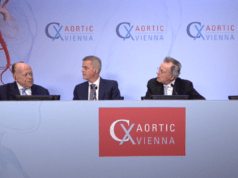
Wednesday’s CX Aortic Vienna programme began with the inaugural joint session of the Austrian Society of Vascular Surgery (ÖGG) and the Swiss Society for Vascular Surgery (SGG). The programme, created by the two societies and delivered in English, piqued global interest. Presentations highlighted the continued existence of type III endoleak and the difficulties of overcoming infection, among other topics.
This session, and all other sessions from day one of CX Aortic Vienna, is available to view on demand. Click here to register and access the recording.
Miriam Kliewer (Vienna, Austria) opened the session with her talk comparing the “conventional” planning process of the fenestrated Anaconda (Terumo Aortic) with a new, digital planning tool using numerical simulation.
Kliewer and colleagues’ comparison of the two models, focusing on the accuracy of the aorta-graft interactions each method provided, led Kliewer to conclude that, “The simulation of a deformable aortic model predicts stent-graft–aorta interaction, and thus oversizing of the graft best. The numerical simulation might also help in complex cases, and save time.”
Thomas Wyss (Winterthur, Switzerland) next took to the online podium to discuss constellations favouring a combined vascular and endovascular approach in type B aortic dissection. Detailing lessons learned from case studies, he informed the CX Aortic Vienna audience: “In summary, at the beginning when urgent TEVAR for acute complicated type B dissections is necessary, it might be difficult to decide what the optimum treatment includes, and whether left subclavian revascularisation is needed. Therefore, timing and technique of left subclavian artery revascularisation can be difficult to choose in such cases. As malperfusion complications may evolve and worsen during the postoperative course, high alertness is necessary.”
Corinna Walter (Vienna, Austria) and colleagues set out to identify factors that may lead to occlusion of connecting stent grafts when used in the treatment of aortoiliac disease. Summarising, Walter informed the CX audience that “Preservation of internal iliac artery blood flow using an iliac branch device (IBD) is feasible, with good technical results. However,” she cautioned, “patient selection and case planning, as well as frequent follow-ups, are crucial. [We should] keep the risk of occlusion at the back of our minds, especially in cases with extensive free-floating stent proportions within the internal iliac aortic aneurysm.”
In the following discussion, moderator Afshin Assadian (Vienna, Austria) commented on the varying prevalence of internal iliac aneurysms, detailing that he had seen more during his time working in Austria than he had working anywhere else in the world.

Sebastien Deglise (Lausanne, Switzerland) next discussed the merits of inner-branched endovascular aortic repair (iBEVAR) for complex aortic aneurysms. Following some illustrative case examples, Deglise concluded: “iBEVAR seems to be a safe and easy-to-use technique for complex aortic disease that can be adapted to different anatomy. It is therefore not in competition with fenestrated endovascular aortic aneurysm repair (FEVAR) or BEVAR, but complementary. It opens new perspectives for emergency treatment with an off-the-shelf device. Long-term data are required to confirm these promising results.”
Markus Plimon (Vienna, Austria) presented his redo-FEVAR cases to the CX Aortic Vienna audience, listing the lessons learned from his experience of performing FEVAR after failed EVAR. “When planning a redo-FEVAR case, one should take into account the possible problems from the short distance between the renal fenestrations and the new bifurcation,” Plimon advised. He concluded that, though redo-FEVAR is safe and feasible, it has a higher complexity due to restrictions imposed by earlier procedures.
Lastly, Maani Hakimi (Lucerne, Switzerland) spoke to the CX Aortic Vienna audience about strategies for open and endovascular repair in septic complications. “To conclude,” he closed, “conversions of septic aortic prosthesis are complex surgical interventions in mostly very sick patients. The variety of methods, and the corresponding infrastructure at specialised centres are essential for achieving successful results. The importance of knowledge of open aortic surgery should be emphasised in particular. It must be the goal of our professional associations to impart these techniques at a high level, and to adequately train the next generation.”













